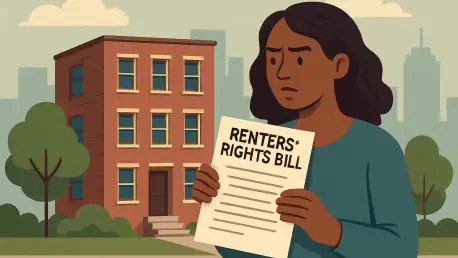In the ever-evolving landscape of the UK’s private rental sector (PRS), a seismic shift is on the horizon with the introduction of the Renters’ Rights Bill by the Labour government, a piece of legislation poised to redefine the relationship between tenants and corporate landlords. Expected to receive Royal Assent this autumn, the bill promises to bolster tenant protections, elevate health and safety standards, and establish fairer rental practices across the board. For corporate landlords, who often oversee expansive property portfolios and play a significant role in the Build to Rent (BTR) sector, this marks a critical juncture. The implications of these changes could reshape operational models, influence investment strategies, and challenge profitability if not navigated with foresight. This article delves into the intricacies of the legislation, alongside broader market trends and demographic shifts, to uncover how these entities must adapt to a rapidly transforming rental environment.
Legislative Changes and Their Implications
Key Provisions of the New Legislation
The Renters’ Rights Bill introduces a robust framework aimed at professionalizing the PRS, with enhanced tenancy security standing as a cornerstone of the reforms. Tenants will likely gain greater stability through measures that prevent arbitrary evictions, while stricter health and safety regulations will mandate landlords to maintain properties at a higher standard. These provisions build on the foundation laid by the earlier Renters’ Reform Bill under the Conservative government, reflecting a shared bipartisan vision for a more balanced rental market. For corporate landlords, this means a shift toward more transparent and accountable operations. Compliance with these rules is not just a legal obligation but a chance to build trust with tenants, potentially enhancing long-term retention rates. However, the transition to these elevated standards may require significant upfront investments in property upgrades and staff training to ensure adherence across large portfolios.
Beyond the immediate focus on tenant rights, the legislation also emphasizes creating an equitable environment where disputes can be resolved fairly and efficiently. This includes potential mechanisms for quicker redress and clearer guidelines on rent adjustments, reducing the friction that often characterizes landlord-tenant interactions. The broader goal is to foster a rental sector that prioritizes quality and fairness over short-term gains. For corporate landlords, particularly those managing hundreds or thousands of units, adapting to these expectations could strain existing operational workflows. Yet, it also presents an opportunity to differentiate themselves in a competitive market by embracing a tenant-centric approach. The challenge lies in balancing these regulatory demands with the financial realities of running large-scale rental businesses, especially in a market already grappling with supply shortages.
Challenges Facing Large Property Managers
The operational impact of the Renters’ Rights Bill on corporate landlords cannot be understated, as meeting new health and safety benchmarks and tenancy protections may drive up costs significantly. Upgrading properties to comply with stringent standards—whether through improved insulation, better fire safety systems, or enhanced accessibility features—requires substantial capital investment. Additionally, the risk of supply constraints looms large, as some landlords might opt to exit the market if the financial burden becomes too heavy, further tightening an already strained housing inventory. This could exacerbate rental price pressures, ironically undermining the bill’s goal of affordability. Corporate entities, with their larger resources, might be better positioned to absorb these costs compared to smaller landlords, but the scale of their operations also amplifies the complexity of implementation across diverse property types and regions.
Stakeholder perspectives, such as those from LRG, a key voice in the rental market, highlight a nuanced view of these reforms. While there is broad support for the push toward higher standards, concerns persist about unintended consequences like market imbalances between supply and demand. LRG advocates for policies that not only enforce regulations but also incentivize growth in rental housing stock to prevent shortages. For corporate landlords, this duality presents a tightrope to walk—ensuring compliance without compromising on expansion or profitability. The potential for regulatory overreach to stifle innovation in property management is another worry, as rigid rules might limit the flexibility needed to address unique tenant needs. Navigating this landscape will require strategic planning, possibly including partnerships with technology providers to streamline compliance processes and maintain operational efficiency.
Market Dynamics and Investment Trends
Demographic Shifts Driving Rental Demand
A profound transformation in the UK’s housing landscape is evident from the staggering 93% increase in privately renting households over the past 15 years, a trend fueled by economic barriers like soaring mortgage rates and a cultural shift toward flexibility among younger generations. This growth far outpaces the modest 3% rise in owner-occupied homes, signaling a fundamental change in how people view housing. The tenant demographic is also diversifying, with 30% of renting households now including dependent children—a doubling since early data points—and 44% classified as “comfortable renters” from middle-class or affluent backgrounds. This evolving renter profile demands more than just a roof over their heads; it calls for quality, amenities, and community engagement. Corporate landlords must pivot their strategies to cater to these varied expectations, ensuring their properties appeal to families and professionals alike while maintaining competitive pricing.
The implications of these demographic shifts extend beyond mere numbers, reshaping the very nature of rental demand in the PRS. Families require larger, more stable accommodations with access to schools and green spaces, while affluent renters often prioritize premium features like smart home technology and on-site facilities. For corporate landlords, this necessitates a rethinking of property design and location priorities, moving away from one-size-fits-all models to tailored offerings that meet specific needs. Investment in suburban areas, where space and community amenities are more readily available, could become a focal point. Additionally, understanding the cultural preference for renting over owning among younger cohorts means anticipating longer tenancy durations and fostering environments that feel like home. Adapting to these trends is not just a response to market forces but a strategic imperative to remain relevant in an increasingly competitive sector.
Growth of the Build to Rent Sector
The Build to Rent (BTR) sector has emerged as a powerhouse in addressing the rising demand for rental housing, with over 273,700 units in the pipeline as of late 2024 and completed units surpassing 120,000—a robust 23% increase in just one year. Notably, regional growth at 31% outstrips London’s 13%, with 69,000 completed homes outside the capital compared to 51,500 within it. This shift toward suburban and regional development reflects a strategic response to where demand is strongest, often driven by affordability and space considerations for families and professionals. For corporate landlords, BTR offers a scalable solution to meet market needs while aligning with the professional standards promoted by the Renters’ Rights Bill. The sector’s emphasis on purpose-built rentals with integrated management ensures consistency in quality, making it a natural fit for the legislative push toward fairness and high standards.
Beyond its sheer scale, the BTR sector represents a paradigm shift in how rental housing is conceptualized and delivered, prioritizing long-term tenant satisfaction through fair leases, reasonable rents, and superior maintenance. Corporate landlords invested in BTR can leverage these attributes to build brand loyalty and differentiate themselves in a crowded market, particularly as tenant expectations rise under new legal protections. The professional management inherent to BTR also facilitates compliance with health and safety regulations, potentially easing the burden of the Renters’ Rights Bill’s mandates. However, the rapid expansion of BTR, especially in regions, requires careful coordination with local infrastructure to avoid over-saturation or community pushback. As this sector continues to grow, it could serve as a blueprint for how corporate landlords can balance profitability with regulatory and social responsibilities, paving the way for a more sustainable rental future.
Evolving Investor Priorities
Emphasis on Sustainability and Ethics
A striking trend reshaping investment in the PRS is the growing emphasis on Environmental, Social, and Governance (ESG) principles, with a remarkable 88% of UK institutional investors prioritizing these factors over traditional financial metrics when making long-term decisions. This shift reflects a broader societal demand for sustainability and ethical practices, influencing how corporate landlords structure their portfolios. The Renters’ Rights Bill, alongside other regulations on energy efficiency, amplifies this focus by mandating improvements that reduce carbon footprints and enhance tenant well-being. For investors and landlords alike, integrating ESG considerations is no longer optional but a competitive necessity. Properties that fail to meet these standards risk losing appeal in a market increasingly driven by values as much as by economics, pushing corporate entities to rethink their approach to development and management.
The practical implications of adopting ESG principles are far-reaching for corporate landlords, requiring investments in energy-efficient technologies, sustainable building materials, and community-focused amenities that foster social cohesion. These initiatives, while costly upfront, can yield long-term benefits through reduced operational expenses and enhanced tenant loyalty. Compliance with legislative mandates on sustainability also positions landlords favorably with regulators and investors who view ESG alignment as a marker of future-proofing. However, the challenge lies in scaling these efforts across large portfolios without compromising financial viability. Strategic partnerships with green technology providers or government incentive programs could mitigate costs, enabling corporate landlords to meet both market expectations and regulatory requirements. As ESG continues to shape investment landscapes, its integration will likely become a defining factor in the success of rental property ventures.
Adapting to a Changing Financial Landscape
The convergence of legislative pressures and evolving investor priorities is creating a complex financial landscape for corporate landlords, where traditional profit-driven models must adapt to new realities. The emphasis on ESG, coupled with the operational demands of the Renters’ Rights Bill, means that funding allocations are increasingly directed toward upgrades and compliance rather than pure expansion. Institutional investors, who are pivotal in driving the BTR sector, are scrutinizing portfolios for alignment with ethical and sustainable goals, often influencing rental pricing strategies and property selection. Corporate landlords must therefore navigate a delicate balance—maintaining attractive returns for investors while investing in the improvements necessary to meet both tenant expectations and legal standards. This shift could redefine how profitability is measured in the rental sector over the coming years.
Moreover, the changing financial landscape underscores the importance of innovation in property management and investment approaches for corporate landlords. Technology-driven solutions, such as automated compliance tracking and energy management systems, can streamline adherence to new regulations while controlling costs. At the same time, diversifying investment into mixed-use developments that combine residential with commercial spaces might offer additional revenue streams to offset the expenses of meeting ESG and legislative requirements. The ability to anticipate and adapt to these financial shifts will be crucial for corporate entities aiming to thrive. As market dynamics continue to evolve, those who can align their strategies with both investor values and regulatory frameworks will likely emerge as leaders in a transformed PRS, setting a precedent for sustainable growth and operational excellence.
Shaping the Future of Rental Housing
Reflecting on Transformative Shifts
Looking back, the introduction of the Renters’ Rights Bill marked a defining chapter for corporate landlords, as it compelled a reevaluation of long-standing practices in the face of heightened tenant protections and rigorous health and safety standards. The legislation, having gained traction, challenged these entities to overhaul their operational frameworks, often at significant cost, to align with a vision of a fairer rental market. Simultaneously, demographic trends revealed a burgeoning and diverse tenant base, while the Build to Rent sector expanded rapidly to meet soaring demand. The rise of ESG principles further reshaped investment priorities, embedding sustainability into the core of business decisions. Together, these forces underscored a pivotal moment in the PRS, where adaptation became synonymous with survival for corporate landlords, pushing them to innovate amidst a backdrop of complex market and regulatory dynamics.
Charting the Path Forward
Moving ahead, corporate landlords must prioritize strategic planning to navigate the lasting impacts of legislative reforms and market evolution. Embracing technology to enhance property management efficiency, from compliance monitoring to tenant communication, could prove invaluable in maintaining competitiveness. Collaboration with policymakers to advocate for balanced regulations that support growth without stifling innovation is equally critical, ensuring that supply shortages do not undermine the bill’s goals. Investing in sustainable practices and community-oriented developments will not only satisfy investor demands but also build stronger tenant relationships. As the rental sector continues to transform, proactive engagement with these multifaceted challenges will position corporate landlords to lead in delivering high-quality, equitable housing solutions that meet the needs of a changing society.









